When you think of Vietnamese food abroad, Pho and Banh Mi often come to mind. While these are incredible, they merely scratch the surface of the vibrant world of Vietnam Culinary. This isn’t just about eating; it’s a journey into a rich culture, where every dish tells a story of history, tradition, and regional identity. From the refined simplicity of the North to the bold, spicy flavors of the Center and the sweet, abundant tastes of the South, Vietnam offers a symphony for the senses. Join me as we explore some must-try dishes that truly embody the spirit of Vietnamese cooking.
Vietnamese cuisine, or Vietnam Culinary, is a delightful blend of textures, bright colors, and piquant flavors. It’s a reflection of the country’s history, geography, and the ingenuity of its people who utilize abundant local produce and special ingredients. Cooks make the most of what each region offers, creating distinct styles across the country. Northern food is often subtle and balanced, central Vietnamese dishes are known for their spice and presentation, while southern cooking tends to be sweeter. No matter where you travel in Vietnam, the food experience is guaranteed to be exceptional.
Essential Experiences in Vietnam Culinary
Let’s dive into some of the iconic dishes that form the backbone of Vietnam Culinary, offering a taste of the country’s diverse gastronomic landscape.
Phở – The Soulful Noodle Soup
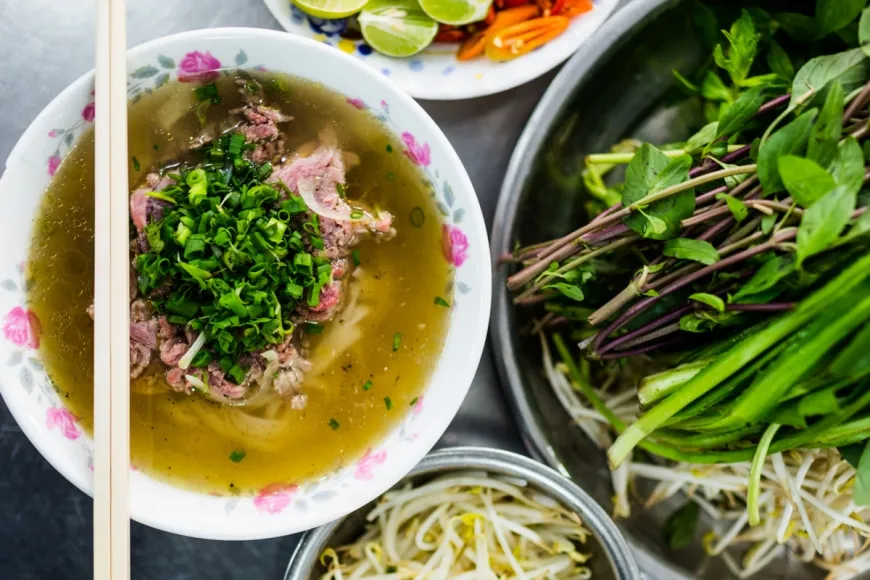 A steaming bowl of classic Vietnam Culinary Pho with beef slices and herbs
A steaming bowl of classic Vietnam Culinary Pho with beef slices and herbs
Phở is arguably the most famous dish in Vietnam Culinary. The word “phở” itself refers to the type of flat rice noodle used. This warming soup features delicate flat rice noodles swimming in a deeply aromatic beef broth, typically served with thin slices of medium-rare beef or boiled chicken. The magic is truly in the broth, which is simmered for hours with fragrant spices like star anise, clove, and cinnamon, lending a natural sweetness and depth.
There are notable regional differences. Phở Hanoi, from the north, is known for its clear broth and is traditionally garnished simply with lemon and chili. In contrast, Phở Nam (southern style) has a richer, sometimes cloudier broth and comes with a generous bouquet of fresh herbs like bean sprouts, basil, and mint, allowing diners to customize their bowl. While often seen as a lunch or dinner item by visitors, Pho is a quintessential Vietnamese breakfast dish, enjoyed by locals on street corners across the country.
Bánh Mì – A Fusion Icon
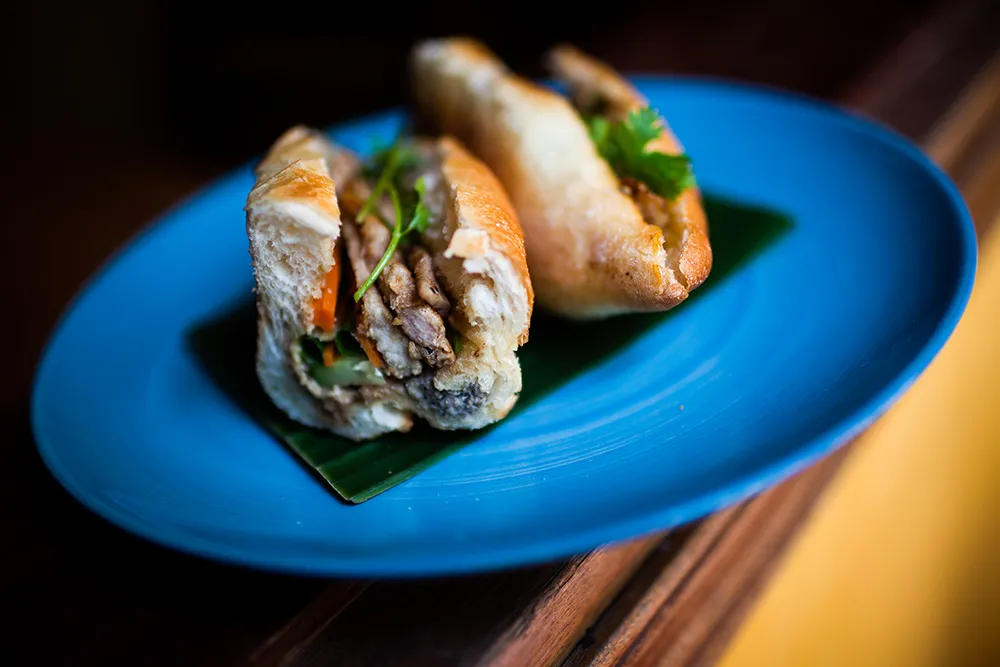 A close-up of a delicious Vietnam Culinary Banh Mi sandwich filled with meat and vegetables
A close-up of a delicious Vietnam Culinary Banh Mi sandwich filled with meat and vegetables
The baguette was introduced during the French colonial era, but Vietnam transformed it into something uniquely its own: the bánh mì. More than just a sandwich, it’s a vibrant medley of flavors and textures packed into a crisp, airy roll. Inside, you’ll find a smear of paté and margarine, followed by layers of pickled vegetables, fresh cilantro, cucumber, and various meats like pork belly or pork floss.
Biting into a fresh bánh mì is a multi-sensory experience – the satisfying crunch of the crust gives way to a soft, chewy interior and a burst of savory, tangy, and fresh flavors from the fillings. It’s a testament to the creativity of Vietnam Culinary, taking an foreign element and making it distinctly Vietnamese. Bánh mì is a popular and inexpensive street food, perfect for a quick and satisfying meal any time of day.
Cơm Tấm – The Hearty Broken Rice Plate
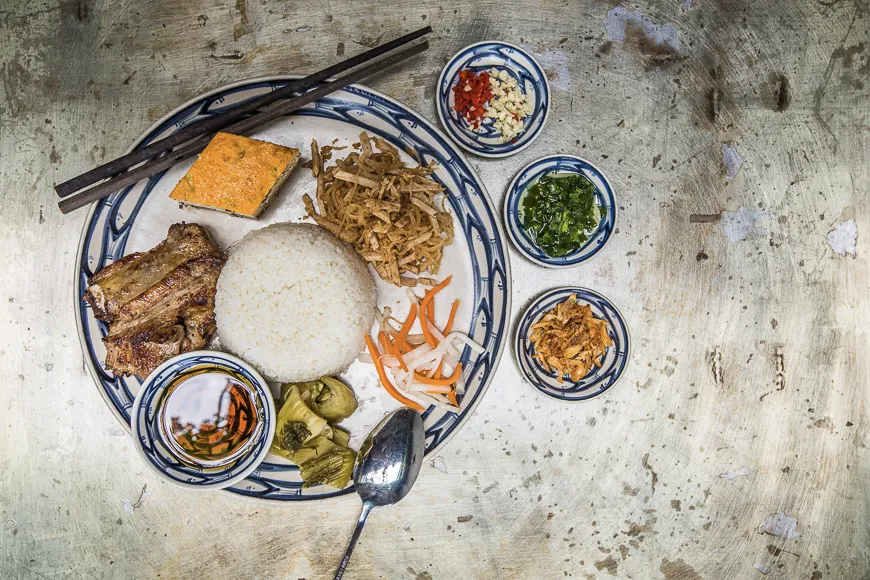 A plate of Vietnam Culinary Com Tam with grilled pork chop and fried egg
A plate of Vietnam Culinary Com Tam with grilled pork chop and fried egg
Cơm tấm, or broken rice, has humble origins. Historically, it was the fractured grains left over after processing that farmers would keep for themselves. Today, it’s a beloved staple, especially for the working class. While simple in concept, a cơm tấm plate can be surprisingly elaborate.
Discover the Best – Where to Go on Vacation in Florida
Your Ultimate Guide – what to eat in destin florida
Discover Fun Things to Do in LA Today
The most popular rendition is cơm tấm sườn nướng ốp la, featuring a caramelized grilled pork chop and a sunny-side-up fried egg served over a generous portion of broken rice. This is then drizzled with nước chấm, the ubiquitous sweet and savory fish sauce, often spiked with chili and a touch of green onion oil. Shredded pickled carrots and daikon, cucumber and tomato slices, and crispy fried shallots or pork rinds are added as garnishes, creating a complete and satisfying meal.
Bún Bò Huế – Hue’s Spicy Noodle Soup
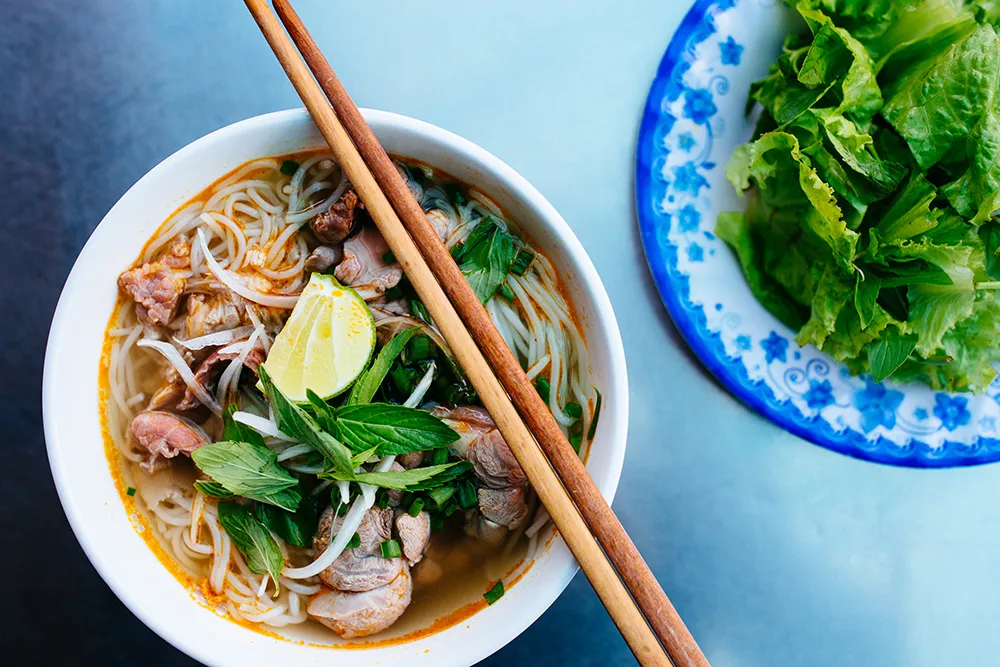 A vibrant bowl of Vietnam Culinary Bun Bo Hue with chili broth and various meats
A vibrant bowl of Vietnam Culinary Bun Bo Hue with chili broth and various meats
Hailing from the former imperial capital, Bún Bò Huế is a proud representative of central Vietnam Culinary, known for its bold flavors and beautiful presentation. The first thing you notice is the broth’s striking reddish hue, a visual promise of its intensity. This spicy and citrusy soup gets its depth from simmering beef bones and liberal amounts of lemongrass.
Tender slices of beef shank, sometimes paired with flash-boiled vegetables, add substance. A unique component is chả lụa, a dense ham paste sausage that has a texture similar to firm tofu, often found lurking amongst the noodles. Bún Bò Huế is a complex and exhilarating bowl, showcasing the central region’s preference for spicy and aromatic dishes.
Cao Lầu – Hoi An’s Secret Noodle
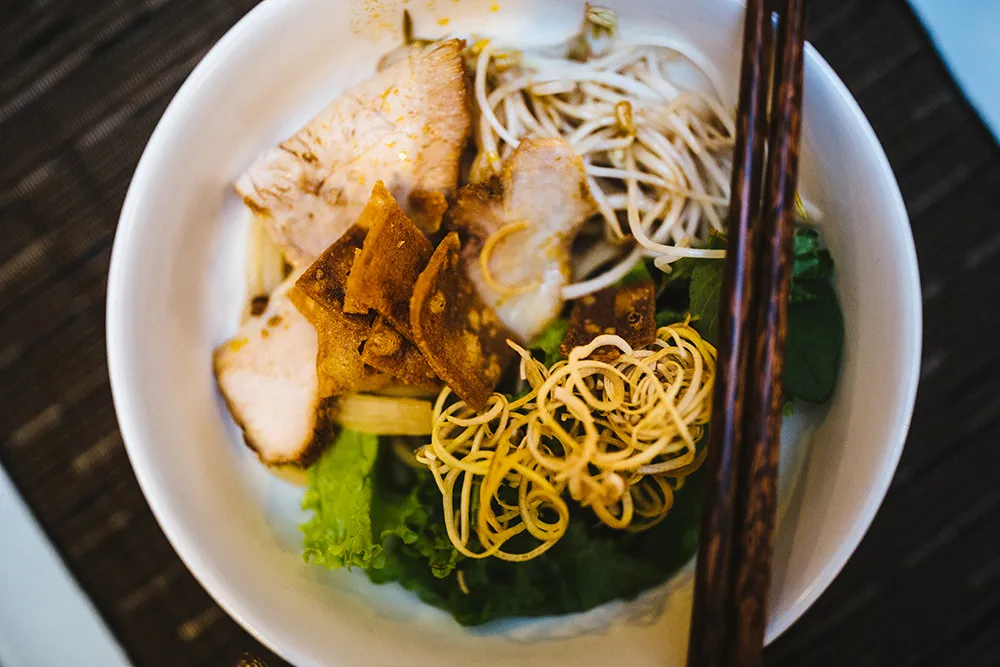 A unique bowl of Vietnam Culinary Cao Lau noodles with pork and herbs
A unique bowl of Vietnam Culinary Cao Lau noodles with pork and herbs
Exclusively found in the charming ancient town of Hoi An, Cao Lầu is a dish shrouded in local legend and historical fusion. It’s said that the unique texture of its thick, udon-like noodles can only be achieved using water from the ancient Ba Le well in Hoi An, rumored to have special properties. This noodle bowl reflects Hoi An’s history as a bustling trading port, with influences from Japanese udon and Chinese char siu pork.
Slices of Chinese barbecued pork are arranged over the Cao Lầu noodles. A small amount of spice-infused broth is added, making it less of a soup and more of a saucy noodle dish. Fresh herbs and crispy pork cracklings complete the ensemble. Trying authentic Cao Lầu in Hoi An is a culinary pilgrimage, connecting you directly to the town’s unique heritage within Vietnam Culinary.
Cơm Gà – Hoi An’s Golden Chicken Rice
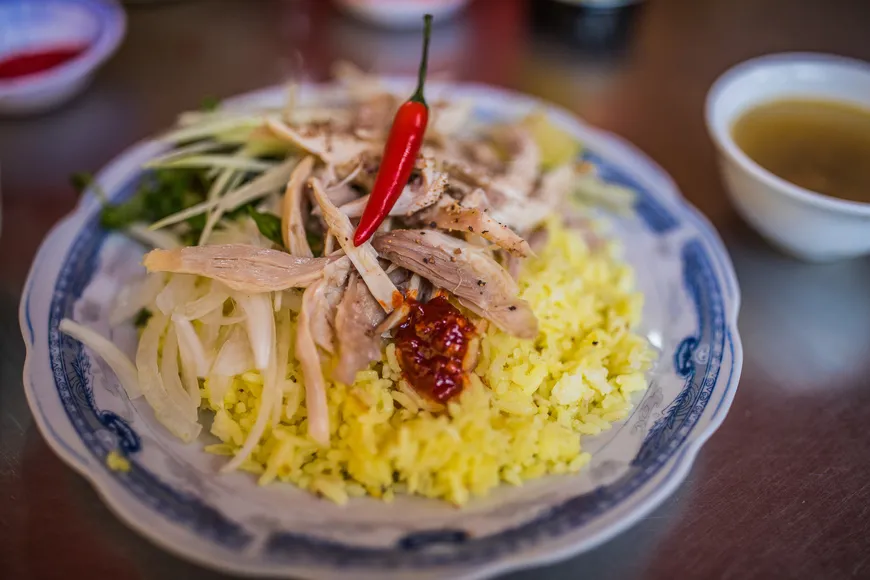 A plate of Vietnam Culinary Com Ga (chicken rice) with shredded chicken and herbs
A plate of Vietnam Culinary Com Ga (chicken rice) with shredded chicken and herbs
Chicken and rice might seem simple, but Hoi An elevates this classic pairing into a local masterpiece known as Cơm Gà. Fresh, tender chicken is shredded and mixed with flavorful fish sauce and onions, served alongside aromatic rice cooked with turmeric, giving it a beautiful golden color.
The dish is accompanied by pickled shallots, radish, and fresh herbs like Vietnamese coriander and hot mint. These fresh components balance the richness of the chicken and rice. Locals have their secrets for the perfect turmeric rice, but the final touch often includes soft, young eggs and a sprinkle of herbs. After exploring Hoi An’s streets, a plate of Cơm Gà is the perfect, comforting reward, showcasing the simple elegance of central Vietnam Culinary.
Mì Quảng – The Colorful Noodle Dish
Hailing from the Quang Nam province in Central Vietnam, Mì Quảng is a vibrant noodle dish that’s often described as part soup, part salad. Its distinctive wide, yellow noodles get their color from turmeric used in the broth, which is made rich with peanut oil. Unlike traditional soups, only a small ladleful of this flavorful broth is added to the bowl.
Mì Quảng can feature various toppings, including shrimp, chicken, pork belly, or even snakehead fish. It’s typically served with a large plate of fresh accompaniments like sliced banana flowers, Vietnamese coriander, basil, and crispy sesame rice crackers called bánh tráng me. This dish highlights the creativity and regional diversity within Vietnam Culinary, offering a unique texture and flavor experience.
Bánh Xèo – The Sizzling Savory Crepe
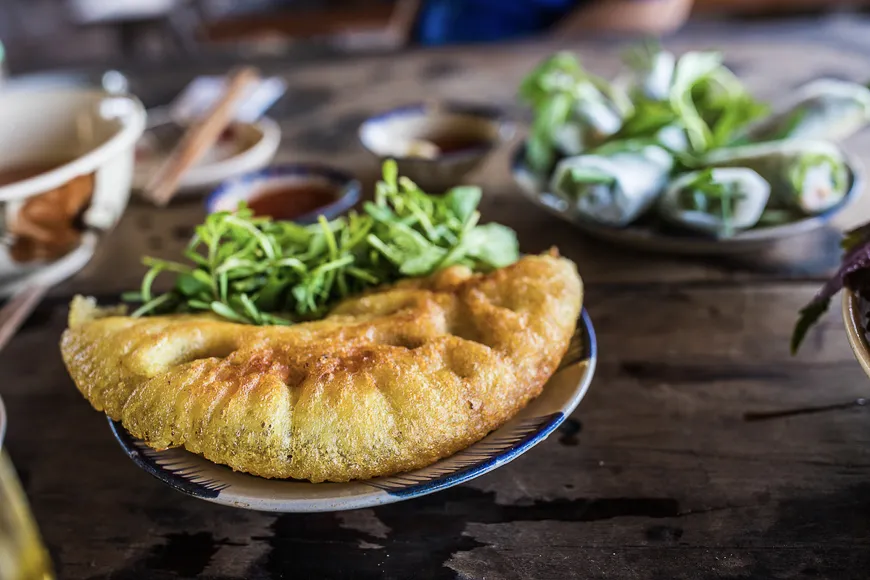 A crispy Vietnam Culinary Banh Xeo savory crepe filled with sprouts and meat
A crispy Vietnam Culinary Banh Xeo savory crepe filled with sprouts and meat
A specialty often associated with the Mekong Delta but popular throughout south and central Vietnam, Bánh Xèo is a delightful savory crepe. Its name comes from the loud sizzling sound (xèo) the batter makes when it hits the hot pan. Watching a skilled cook swirl the rice flour and coconut milk batter, tinted yellow with turmeric, is part of the experience.
The large, thin crepe is filled with slices of boiled pork, minced pork, shrimp, and bean sprouts, then folded in half. The goal is a crispy exterior with a tender filling. Bánh Xèo is best enjoyed hot off the skillet before it loses its crispness. It’s often served with a variety of fresh greens and herbs for wrapping, and dipped in nước chấm, showcasing another example of French influence reinterpreted through Vietnam Culinary.
Bún Chả – Hanoi’s Grilling Sensation
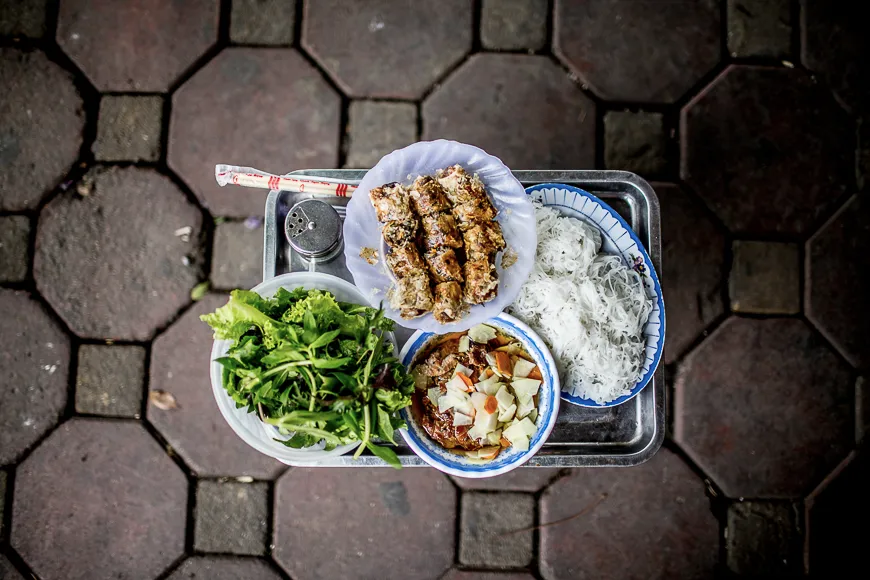 A spread of Vietnam Culinary Bun Cha with grilled pork, vermicelli, and broth
A spread of Vietnam Culinary Bun Cha with grilled pork, vermicelli, and broth
Bún Chả is a Hanoi specialty that gained international fame after President Obama and Anthony Bourdain famously enjoyed a bowl together. But for locals in Hanoi’s Old Quarter, the scent of pork grilling over charcoal around lunchtime has always been an irresistible call.
This classic northern dish consists of cold rice vermicelli noodles (bún), seasoned grilled pork patties, slices of grilled pork belly, and a generous mound of fresh herbs and salad greens. The key component is the dipping broth, a warm fish sauce-based mixture often containing pickled green papaya or carrot, and importantly, the grilled pork patties. The typical way to eat Bún Chả is to take small bundles of vermicelli and herbs and dunk them into the broth with the pork, creating a perfect bite every time. It’s a cornerstone of northern Vietnam Culinary.
Xôi – Versatile Sticky Rice
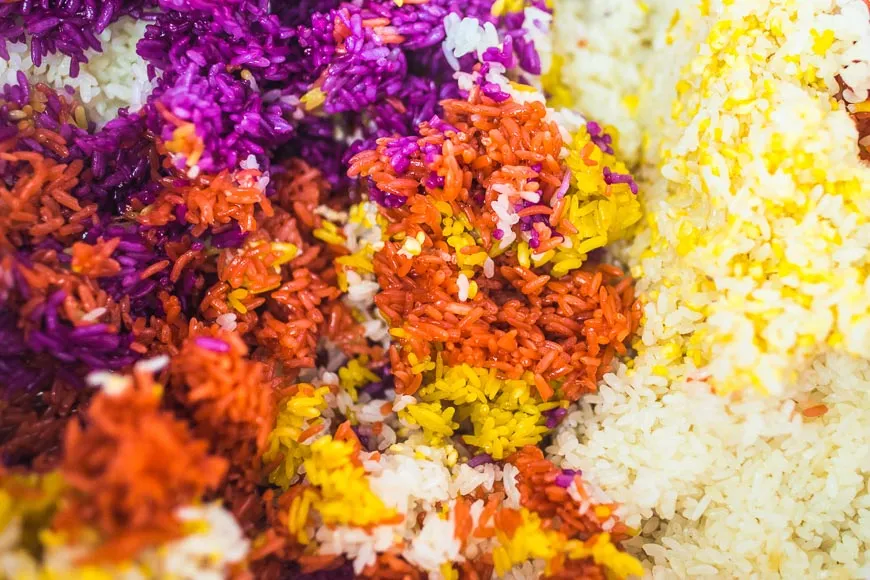 Colorful Vietnam Culinary Xoi (sticky rice) topped with various ingredients
Colorful Vietnam Culinary Xoi (sticky rice) topped with various ingredients
Xôi, or Vietnamese sticky rice, is a dense, glutinous staple that can be enjoyed in both savory and sweet forms, setting it apart from other sticky rice preparations in the region. Xôi mặn, the savory version, is a popular and inexpensive breakfast option, often topped with ingredients like dried shallots, peanuts, mung bean paste, and sometimes even fried egg or sausage.
For those with a sweet tooth, there are over 20 varieties of xôi ngọt. A visually stunning example is xôi ngũ sắc, the five-colored sticky rice, which features vibrant layers of purple, green, red, yellow, and white, naturally pigmented using plant extracts. Xôi showcases the flexibility and creativity within Vietnam Culinary, turning a simple grain into a versatile and flavorful dish.
Bánh Bèo – Delicate Steamed Rice Cakes
 Small Vietnam Culinary Banh Beo steamed rice cakes topped with shrimp and pork rinds
Small Vietnam Culinary Banh Beo steamed rice cakes topped with shrimp and pork rinds
From Hue in Central Vietnam, Bánh Bèo are delicate, bite-sized steamed rice cakes, often served as an appetizer akin to Vietnamese tapas. Each small, slightly chewy disc is topped with a spoonful of creamy mung bean paste and toasted dried shrimp. They are often garnished with crispy elements like croutons or the more indulgent tép mỡ (fried pork fat).
A perfectly steamed bánh bèo should have a slight dimple in the center. These little cakes are typically served with nước chấm, allowing you to dip each one before popping it into your mouth. Bánh Bèo offers a taste of Hue’s refined imperial cuisine, focusing on delicate flavors and textures within Vietnam Culinary.
Bún Riêu – The Tangy Crab Noodle Soup
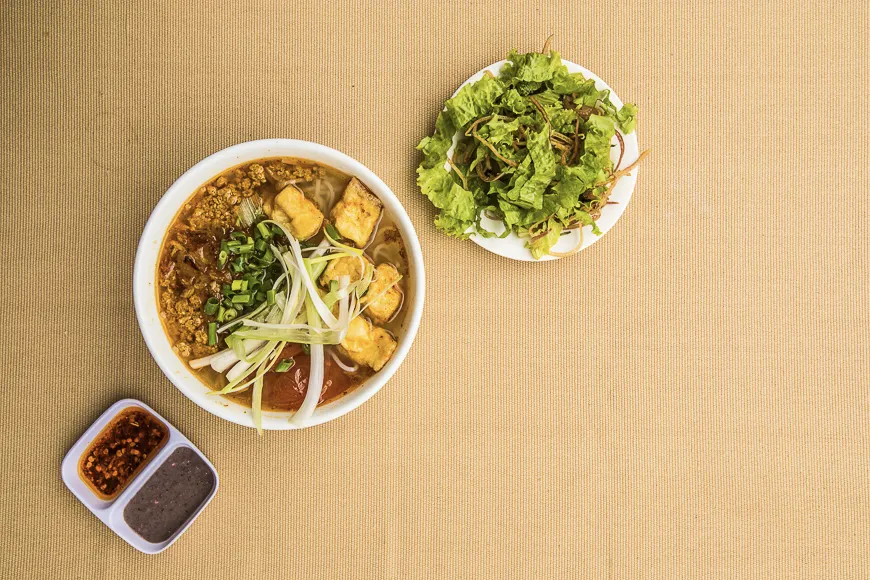 A rich bowl of Vietnam Culinary Bun Rieu with tomato broth and crab cakes
A rich bowl of Vietnam Culinary Bun Rieu with tomato broth and crab cakes
Bún Riêu is a flavorful noodle soup where the vibrant combination of crab and tomato creates a truly standout acidity and richness. The hearty broth is made from a base of fresh crab, often intensified by pounding the crab shells and straining the liquid.
Components include slippery rice vermicelli (bún), fresh crab meat, blocks of tofu, and stewed tomatoes. Floating in the soup are soft, pillowy clusters made from minced crab combined with ground pork and egg, which melt in your mouth. Bún Riêu is a labor-intensive dish to prepare authentically, but the result is a complex and incredibly satisfying bowl that is a favorite across Vietnam.
Gỏi Cuốn – Fresh Spring Rolls
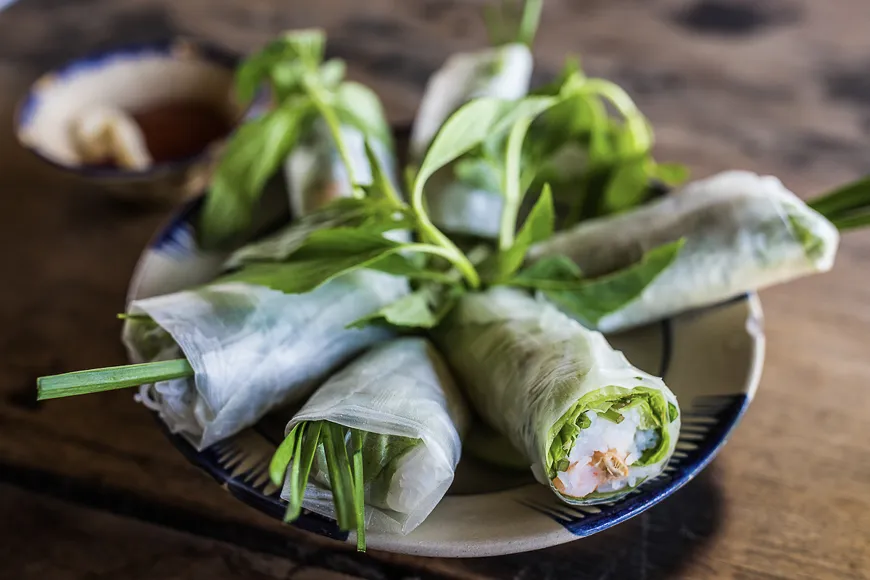 Healthy Vietnam Culinary Goi Cuon fresh spring rolls with shrimp and herbs
Healthy Vietnam Culinary Goi Cuon fresh spring rolls with shrimp and herbs
A refreshing and healthy option in Vietnam Culinary are Gỏi Cuốn, often called fresh spring rolls. Unlike their fried counterparts, these rolls are made with soft, translucent sheets of dampened rice paper wrapped snugly around a variety of fresh fillings.
Inside, you’ll find leafy greens, fragrant mint and coriander, sometimes thin rice vermicelli, and protein – most commonly a combination of pork tenderloin and shelled shrimp. A chive stalk often pokes out the end. Gỏi Cuốn are typically served with a dipping sauce, either a nutty hoisin-based sauce or classic nước chấm. They offer a light, crisp, and incredibly fresh burst of flavor.
Bánh Căn – Savory Mini Pancakes
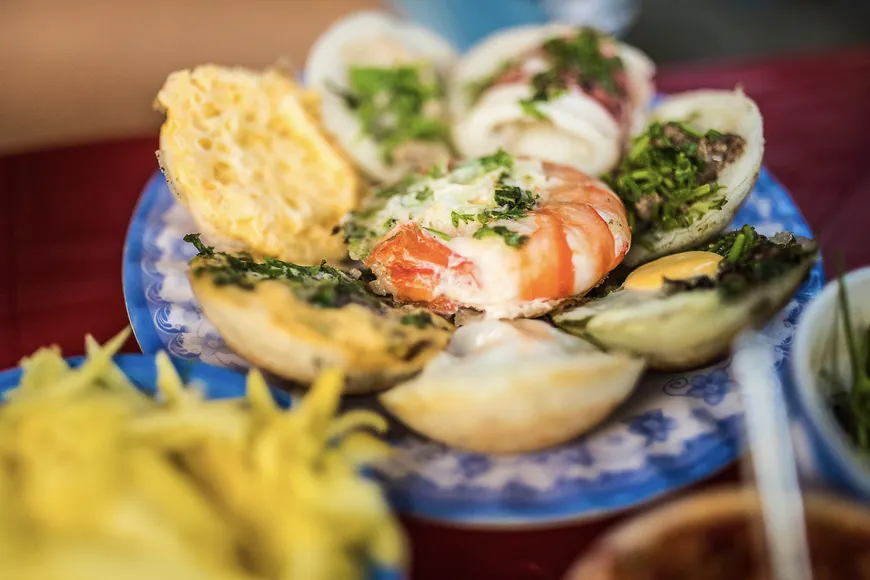 Small, round Vietnam Culinary Banh Can savory pancakes in a tray
Small, round Vietnam Culinary Banh Can savory pancakes in a tray
Bánh Căn are bite-sized savory pancakes beloved in south-central Vietnam. They are cooked in a special earthenware grill, made from a batter of rice flour combined with a cracked quail egg and chopped green onions. The result is a delightful little disk with a slightly crispy edge and soft center.
Traditionally served plain, modern Bánh Căn often come topped with shrimp or pork. They are typically served with a dipping broth that can include green onions and meatballs, adding another layer of flavor and texture. These mini pancakes are a popular street food snack, perfect for sampling the diverse offerings of Vietnam Culinary.
Hủ Tiếu Nam Vang – Southern Noodle Delight
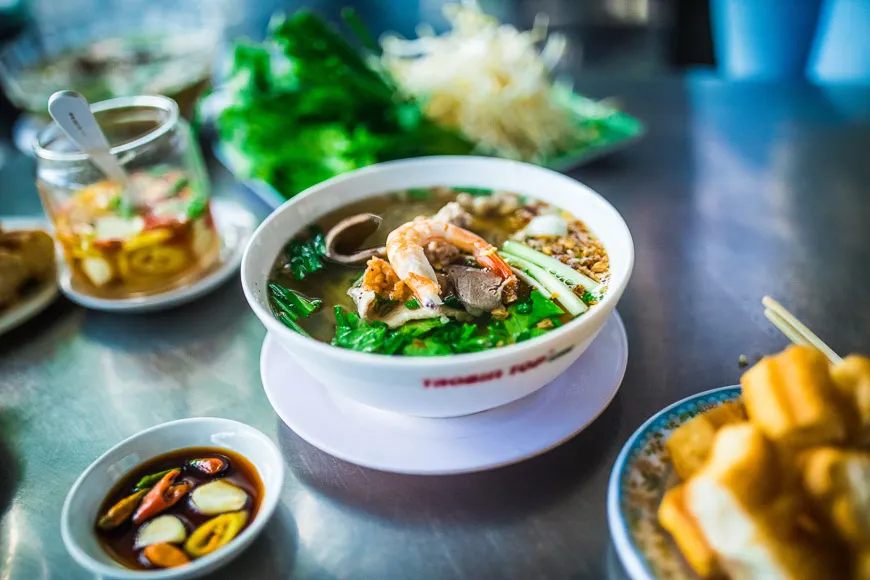 A bowl of Vietnam Culinary Hu Tieu Nam Vang noodles with various toppings
A bowl of Vietnam Culinary Hu Tieu Nam Vang noodles with various toppings
Hủ Tiếu is a standard noodle dish in southern Vietnam, with variations also found in Cambodia (kuy teav) and Thailand (guay tiew). It can be served either wet (nước), in a clear pork bone broth, or dry (khô), with the broth served on the side.
The definitive version is Hủ Tiếu Nam Vang, which includes a variety of toppings like pork on the bone, boiled liver, shrimp, and a quail egg. Some versions might also include chunks of congealed pork blood (though you can request to omit this). The broth is peppery and often has a noticeable sweetness from rock sugar, finished with chopped green onions. It’s a complex and satisfying noodle soup that highlights southern preferences in Vietnam Culinary.
Chả Cá – Hanoi’s Dill Fish Specialty
 Sizzling Vietnam Culinary Cha Ca fish with dill and green onions
Sizzling Vietnam Culinary Cha Ca fish with dill and green onions
Chả Cá is a unique and fragrant delicacy from Hanoi, standing out in northern Vietnam Culinary with its bold flavors and presentation. Chunks of flaky white fish, typically Hemibagrus, are marinated in turmeric, adding a beautiful yellow hue. They are then sautéed in butter on a hot skillet.
Generous amounts of fresh dill and green onion are added to the skillet, wilting around the fish as they cook. The dish is highly aromatic. It’s usually served with rice vermicelli, peanuts, and herbs, and dipped in mắm tôm (shrimp paste) or nước chấm. Chả Cá is not just a meal; it’s an interactive dining experience, symbolizing the sophistication of Hanoi’s gastronomy.
Nộm Hoa Chuối – Refreshing Banana Flower Salad
 A colorful Vietnam Culinary Nom Hoa Chuoi banana flower salad
A colorful Vietnam Culinary Nom Hoa Chuoi banana flower salad
Nộm Hoa Chuối is a stunning and refreshing salad made from finely shredded banana flowers tossed with pickled carrots, coriander, sometimes lotus root, cabbage, and seasonal fruits like pomelo or green mango. It’s a vibrant medley of colors and textures.
This salad can be served as a vegetarian dish or with added protein like chicken, beef, or shrimp. It’s bound together with a light nước chấm dressing and garnished with crushed peanuts and bird’s eye chili. A squeeze of lime adds a bright, zesty punch, making Nộm Hoa Chuối a perfect light and flavorful dish, showcasing the fresh, vegetable-forward side of Vietnam Culinary.
Bánh Cuốn – Delicate Steamed Rice Rolls
 Steamed Vietnam Culinary Banh Cuon rice rolls with filling and toppings
Steamed Vietnam Culinary Banh Cuon rice rolls with filling and toppings
Bánh Cuốn are delicate steamed rice rolls, a popular breakfast item in northern Vietnam. Thin, large sheets of steamed rice flour batter are quickly made to order. These sheets are then filled with a mixture of seasoned minced pork and wood ear mushrooms, gently folded, and sometimes chopped into smaller pieces.
The rolls are typically topped with crispy dried shallots and served with a side bowl of warm nước chấm dipping sauce, often containing slices of Vietnamese pork sausage (chả lụa). Locals often add fresh herbs to their dipping sauce or directly to the rolls. Bánh Cuốn offers a light yet flavorful start to the day, highlighting the simple elegance found in Vietnam Culinary.
Bún Chả Cá – Fish Cake Noodle Soup
 A bowl of Vietnam Culinary Bun Cha Ca fish cake noodle soup
A bowl of Vietnam Culinary Bun Cha Ca fish cake noodle soup
Bún Chả Cá is a fish cake noodle soup with many regional variations across Vietnam. The core components are rice vermicelli noodles (bún), fish cakes (chả cá), and fresh herbs in a flavorful broth. Regional twists add local character.
The version from the central coastal city of Nha Trang, for example, often includes bouncy squid cakes (chả mực), dill, fried green onions, and tomatoes in the broth, giving it a light, slightly sour flavor profile. Served with a side of fresh greens and a squeeze of lime, Bún Chả Cá is a comforting and popular dish, especially in coastal areas, showcasing the diversity even within specific dish types in Vietnam Culinary.
Bún Bò Cuốn Lá Lốt – Grilled Beef in Betel Leaves
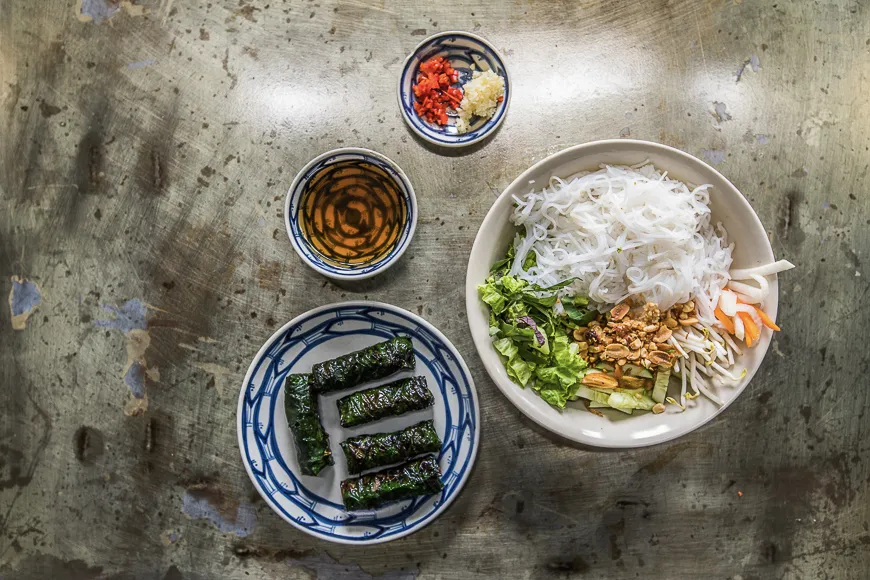 Grilled Vietnam Culinary Bo La Lot beef rolls wrapped in betel leaves
Grilled Vietnam Culinary Bo La Lot beef rolls wrapped in betel leaves
A fascinating southern specialty is Bún Bò Cuốn Lá Lốt, featuring seasoned minced beef mixed with garlic and shallots, wrapped tightly in lá lốt (wild betel leaves) like small cigars, and then grilled over charcoal. The grilling imparts a smoky aroma and slightly crispy exterior to the betel leaf, while sealing in the juicy, flavorful beef filling.
Bò Lá Lốt offers unexpected peppery bursts of flavor. It can be enjoyed on its own, with rice vermicelli noodles (bún), or wrapped in rice paper with fresh herbs, adding playful textures. Dipped in a spicy fish sauce or fermented shrimp paste sauce (mắm nêm), these grilled rolls are a must-try for meat lovers exploring southern Vietnam Culinary.
Chè – Sweet Vietnamese Desserts
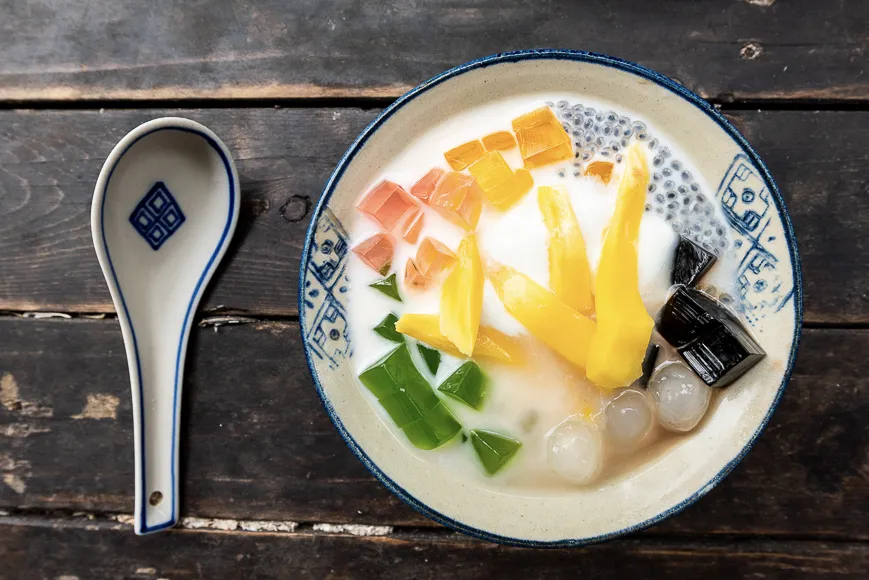 Colorful bowls of Vietnam Culinary Che dessert soup/pudding
Colorful bowls of Vietnam Culinary Che dessert soup/pudding
Chè refers to a category of sweet Vietnamese desserts, which can be served hot or cold, often in the form of a pudding or dessert soup. Cold chè is particularly popular, filled with a variety of ingredients like jellies, beans, seeds, and tropical fruits such as bananas, mangoes, and longan, frequently finished with rich coconut cream and crushed ice.
Trying Chè is always a textural adventure, encountering components like coconut shreds, lotus seeds, and various types of jellies and tapioca pearls in a sweet, syrupy base. A visually stunning example is chè ba màu (three-colored chè), often called the rainbow dessert, layered with red beans, mashed mung beans, and pandan jelly, topped with ice and coconut milk. Chè provides a sweet and refreshing conclusion to a meal, highlighting the diverse and playful side of Vietnam Culinary.
Frequently Asked Questions About Vietnam Culinary
What are the main characteristics of Vietnam Culinary?
Vietnam Culinary is characterized by its fresh ingredients, minimal use of oil, reliance on herbs and vegetables, complementary textures, and the prominent use of fish sauce (nước mắm). Flavors are typically balanced, combining sweet, salty, sour, and spicy elements.
How does Vietnam Culinary differ by region?
Regional differences are significant. Northern cuisine (e.g., Hanoi) is known for its subtle and balanced flavors. Central Vietnamese cuisine (e.g., Hue) is spicier and emphasizes presentation. Southern Vietnamese cuisine (e.g., Ho Chi Minh City, Mekong Delta) tends to be sweeter due to the use of sugar and coconut milk, and incorporates more tropical fruits and herbs.
What are some must-try street foods in Vietnam Culinary?
Many iconic dishes are street foods, including Phở, Bánh Mì, Bún Chả (Hanoi), Cơm Tấm (South), Bánh Xèo, and various noodle soups like Bún Bò Huế and Mì Quảng. Exploring street food stalls is essential to experiencing authentic Vietnam Culinary.
Is Vietnam Culinary generally spicy?
While some dishes, particularly from Central Vietnam like Bún Bò Huế or certain preparations of Mì Quảng, can be quite spicy, not all Vietnamese food is hot. Many dishes are balanced or offer chili and spices on the side, allowing diners to adjust the heat level to their preference.
Is Vietnam Culinary considered healthy?
Yes, Vietnam Culinary is often considered one of the healthier cuisines globally. It emphasizes fresh vegetables, herbs, lean proteins, and uses less oil compared to many other cuisines. Steaming, grilling, and preparing fresh rolls are common cooking methods.
From bustling street corners to quiet family kitchens, Vietnam Culinary offers an unforgettable exploration of flavor, history, and community. Each dish is more than just a meal; it’s an invitation to connect with the soul of the country. So, pack your bags and bring your appetite – the adventure awaits!
